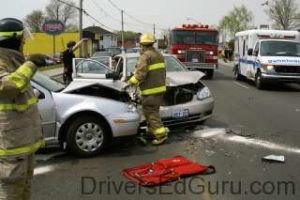What to do in a Major Accident

Photo source: wordfreak
If your teen is ever in a major car accident, chances are that in the commotion and panic he will not remember all of your advice on what do to in case of an accident.
All drivers, not just new ones, should carry an auto accident report kit in the car. The kit should include accident procedures and an accident report form. When you are frantic, the last thing you want is to worry about insurance guidelines or trying to find a piece of paper. You should also always have a pen in your car.
You must file a police report
A major accident will be handled differently than a minor accident because more action, attention, and detail is required. Whereas some minor accidents are not reported to police or insurance companies, major accidents will require both police and insurance company involvement. Major car accidents are those with injury, those that cannot be moved out of traffic, or those that have caused significant property damage.
Check for injuries and call 911
After any car accident, try to remain as calm as possible. Check yourself and everyone involved for injuries. If there are serious injuries, make sure you request an ambulance when you call 911. If you are located in an unfamiliar area, look for any street sign or exit sign that can give clues as to your location. This will obviously speed assistance.
Do not move a seriously injured victim as doing so could worsen the injury. However, if the victim is in danger of further harm, such as a car fire, then move the victim to safety.
If possible, move your car off the road
Once you have confirmed that all people involved are safe, then you can worry about the cars. If possible and legal, move the cars out of traffic’s way and turn the cars off. Check your state laws, since in some states it is against the law to move cars from the accident scene.
If the car cannot be moved, turn the car off and turn on the hazard lights. Use road flares if available and necessary. Road flares will be much more visible than your hazard lights at night and in fog, rain, or snow. Do not sit in or stand near your car if there is any risk of being hit by another car.
Never admit or assign blame
Never admit fault to anyone, apologize, or accuse another driver of being at fault. An accident scene is not the place for argument, so keep calm and polite. Do not sign any papers unless given to you by the police or your insurance company.
When police arrive, they will make an accident report. Be cooperative, truthful, and state the facts. Remember, anything you say to the police can be used against you later. Do not admit fault to the police, even if you think it was your fault. The other driver may have also made a mistake that contributed to the accident. The insurance companies will work this out.
You should have an auto accident report kit in your car (if not, then buy one!). Fill out the accident report form with information about the other driver(s), any witnesses, the scene, damage to the cars, and an explanation of what happened. Do this immediately while everything is fresh in your mind. Be as specific as possible. Take photos of the damage to the cars and of the accident scene. Your own records of the accident can serve as a supplement to the police report for your insurance company.
Driving again after a car accident
After your teen is involved in his first car accident, expect him to be nervous about driving again. Be understanding if he does not want to drive on highways or in inclement weather for a while. You do not want your child driving if he is overly nervous or distracted. However, he eventually needs to get back on the road. You don’t want your child to be forever scared of driving. Make sure that a lesson has been learned and that he is truly ready to drive. After that, pray it never happens again!
The information provided in this post is opinion and not legal advice.
Photo source: http://www.flickr.com/photos/wordfreak/

